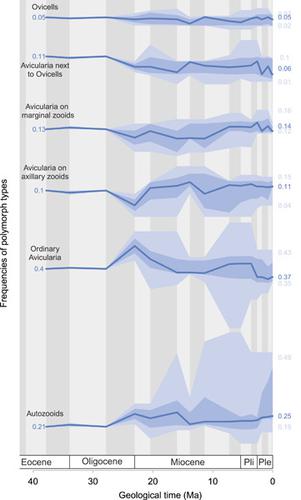当前位置:
X-MOL 学术
›
J. Exp. Zool. B Mol. Dev. Evol.
›
论文详情
Our official English website, www.x-mol.net, welcomes your feedback! (Note: you will need to create a separate account there.)
An ecological driver for the macroevolution of morphological polymorphism within colonial invertebrates
Journal of Experimental Zoology-B: Molecular and Developmental Evolution ( IF 2.2 ) Pub Date : 2020-05-23 , DOI: 10.1002/jez.b.22955 Carl Simpson 1
Journal of Experimental Zoology-B: Molecular and Developmental Evolution ( IF 2.2 ) Pub Date : 2020-05-23 , DOI: 10.1002/jez.b.22955 Carl Simpson 1
Affiliation

|
Colonial marine invertebrates, such as corals and bryozoans, have modular growth. Individual modules within a colony are homologous to an individual solitary animal body. But in contrast to the predominately sexual origin of solitary animal bodies, modules within a colony are always produced asexually. The repetition of modules and the indeterminism of their organization gives colonies the ability to grow in ways solitary animals cannot. Colonial invertebrates consequently grow in such a way as to resemble weeds, bushes, or trees. The multitude of growth forms of colonial invertebrates arise from differences how individual colonies within a species tend to invest their energy into modular growth, persistence, asexual propagation, and sexual reproduction. Moreover, many colonial invertebrates possess several body types, morphological polymorphism among modules, where modules qualitatively differ in shape, size, and function. In this paper, I propose a mechanism that links the origin of novel body types to the evolution of life‐history strategies among species. When colonies first evolve from solitary ancestors, the life‐history strategy of the colony remains constrained by the life‐history strategies of the individual modules within the colony until a new polymorph type evolves. The addition of novel body types within a colony introduces potential variation in life‐history strategies. Colonies can then change strategies by regulating the frequencies of body types within the colony. This, along with the ability of body types to simplify their structure permits colonies to evolve more complex life‐histories. Each new polymorph type that evolves permits more variation in colonial life‐histories to exist.
中文翻译:

群落无脊椎动物形态多态性宏观进化的生态驱动力
殖民地海洋无脊椎动物,如珊瑚和苔藓动物,具有模块化生长。群体内的各个模块与单个单独的动物体同源。但与独居动物的主要有性起源相反,群体内的模块总是无性产生的。模块的重复及其组织的不确定性使殖民地能够以孤独的动物无法实现的方式成长。因此,殖民地无脊椎动物以类似于杂草、灌木或树木的方式生长。群落无脊椎动物的多种生长形式源于物种内的个体群落倾向于将能量投入模块化生长、持久性、无性繁殖和有性繁殖的差异。此外,许多殖民地无脊椎动物具有多种体型,模块之间的形态多态性,其中模块在形状、大小和功能上存在质的不同。在本文中,我提出了一种机制,将新体型的起源与物种间生活史策略的进化联系起来。当群体首次从孤立的祖先进化而来时,群体的生活史策略仍然受到群体内各个模块的生活史策略的约束,直到进化出新的多晶型类型。在群体中增加新的身体类型会导致生活史策略的潜在变化。然后,菌落可以通过调节菌落内身体类型的频率来改变策略。这一点,再加上身体类型简化其结构的能力,使殖民地能够进化出更复杂的生活史。
更新日期:2020-05-23
中文翻译:

群落无脊椎动物形态多态性宏观进化的生态驱动力
殖民地海洋无脊椎动物,如珊瑚和苔藓动物,具有模块化生长。群体内的各个模块与单个单独的动物体同源。但与独居动物的主要有性起源相反,群体内的模块总是无性产生的。模块的重复及其组织的不确定性使殖民地能够以孤独的动物无法实现的方式成长。因此,殖民地无脊椎动物以类似于杂草、灌木或树木的方式生长。群落无脊椎动物的多种生长形式源于物种内的个体群落倾向于将能量投入模块化生长、持久性、无性繁殖和有性繁殖的差异。此外,许多殖民地无脊椎动物具有多种体型,模块之间的形态多态性,其中模块在形状、大小和功能上存在质的不同。在本文中,我提出了一种机制,将新体型的起源与物种间生活史策略的进化联系起来。当群体首次从孤立的祖先进化而来时,群体的生活史策略仍然受到群体内各个模块的生活史策略的约束,直到进化出新的多晶型类型。在群体中增加新的身体类型会导致生活史策略的潜在变化。然后,菌落可以通过调节菌落内身体类型的频率来改变策略。这一点,再加上身体类型简化其结构的能力,使殖民地能够进化出更复杂的生活史。



























 京公网安备 11010802027423号
京公网安备 11010802027423号